Space exploration has always captivated human imagination, and India has been steadily making its mark in the field with remarkable achievements. Chandrayaan-3, the country's third lunar exploration mission, is eagerly awaited as it promises to build upon the successes of its predecessors. In this article, we'll delve into the significance of Chandrayaan-3, its objectives, and the advancements it brings to India's space endeavors.
1. Continuing the Lunar Legacy:
Chandrayaan-3 follows in the footsteps of its predecessors, Chandrayaan-1 and Chandrayaan-2. While the first mission made a significant discovery of water molecules on the Moon, the second one attempted a soft landing on the lunar surface. Unfortunately, the lander lost communication during the descent. Chandrayaan-3 aims to overcome this setback and successfully achieve a soft landing, marking India's prowess in landing technology.
2. The Objective: Successful Soft Landing:
The primary objective of Chandrayaan-3 is to accomplish a successful soft landing on the Moon's surface. The mission aims to deploy a lander and rover to explore and analyze the lunar terrain, composition, and atmosphere. A successful soft landing would be a remarkable achievement, showcasing India's advancements in space technology and positioning the nation as a capable player in the global space community.
3. Technological Advancements:
Chandrayaan-3 incorporates technological enhancements to ensure a smooth landing process. Learning from the experiences of Chandrayaan-2, the mission will focus on improving communication systems, navigation techniques, and overall landing precision. These advancements not only contribute to the mission's success but also add to India's expertise in space exploration.
4. Scientific Exploration:
Beyond the landing, Chandrayaan-3 is equipped to carry out scientific exploration of the lunar surface. The rover is expected to study the Moon's geology, mineral composition, and distribution of elements. This data could provide insights into the Moon's formation, evolution, and its potential as a resource-rich celestial body.
5. International Collaboration:
Chandrayaan-3 highlights India's commitment to international collaboration in space exploration. The mission may include contributions from other countries, fostering partnerships and knowledge exchange. Collaborative efforts not only reduce costs but also bring together diverse expertise, making the mission more robust and comprehensive.
6. Inspiring the Next Generation:
India's space missions have consistently inspired young minds to pursue careers in science, technology, engineering, and mathematics (STEM). Chandrayaan-3's journey will undoubtedly ignite curiosity among students and enthusiasts, motivating them to delve deeper into space exploration and technological innovation.
7. Future Prospects:
The success of Chandrayaan-3 could pave the way for more ambitious lunar missions, including sample return missions or even human exploration. India's space agency, ISRO, has expressed interest in these endeavors, and the insights gained from Chandrayaan-3 will be crucial in planning and executing such missions.
Conclusion:
Chandrayaan-3 represents India's unwavering determination to explore the cosmos and make significant contributions to space exploration. With its focus on achieving a successful soft landing on the Moon, coupled with technological advancements and scientific objectives, the mission stands as a testament to India's progress in space research and technology. As we await its launch, the excitement and anticipation surrounding Chandrayaan-3 reflect the nation's enthusiasm to reach new frontiers in the realm of space.



